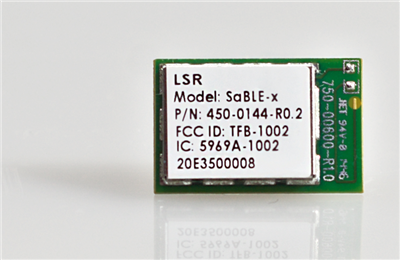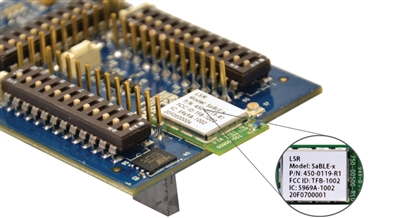SSZTCI3 july 2015 CC2640
While the exact projections of “just how big” industry analysts estimate the Internet of Things (IoT) to be, this much is clear: To meet and exceed those estimated volumes, adding wireless connectivity to a product is a requirement and it must be simple, it must be power-efficient and it simply must work. More and more, the “things” of the IoT will be items that require a small form factor, long battery life and will need to enable mobile devices to act as a user interface with these products intuitively and reliably.

When TI announced the SimpleLink ultra-low power wireless microcontroller (MCU) family this past February, including the new Bluetooth® low energy CC2640 wireless MCU, it was clear to the product team at LSR (and in short order, to our customers as well) that TI understood the needs for the IoT and set a new bar for Bluetooth Smart solutions moving forward. LSR, as a platinum partner in the TI Design Network, sought to amplify the design benefits of the CC2640 solution to our customers by placing it within a certified module, the SaBLE-x Bluetooth low energy module.
So let’s get back to those three key requirements for successful IoT designs, and ask the question: How does the SaBLE-x offering, powered by TI’s CC2640, achieve them?
Requirement 1: Must Be Simple.
As the IoT brings wireless capabilities into the product lines of more and more companies, development teams who may not have deep experience in Bluetooth communication protocols will need the tools and resources to get the job done and be able to get to market fast. With a certified modular solution, LSR’s renowned technical support and design tools and TI’s powerful tech resources, customers with any level of wireless expertise can succeed. A few aspects to highlight:
- TI’s software & tools: The CC2640 is supported with TI’s BLE-Stack v2.0, one of the most mature and highly-respected stacks in the industry, the SmartRF™ Studio and full support of integrated development environments (IDE) such as IAR and Code Composer Studio™ IDE
- LSR’s Serial-to-BLE API: For many IoT applications, Bluetooth low energy connectivity is being added to a product design with an existing MCU onboard. LSR’s innovative Serial-to-BLE API and C-code generation tools provides a simple, straightforward solution for sharing data between host MCU and SaBLE-x module via UART. The Serial-to-BLE API is just part of LSR’s new Developer Tool Suite PC desktop application.
- Bluetooth SIG qualification process: By properly implementing the Bluetooth-qualified BLE stack from TI (QDID # 61713) and the Bluetooth-qualified SaBLE-x module (QDID # 66911) into a product design, additional testing time, expenses, and design risk are all bypassed and the qualification process becomes very streamlined. In addition to the Bluetooth qualification process, the SaBLE-x also provides regulatory certification with FCC, IC, ETSI, Giteki, and C-Tick. This means dramatically reduced compliance testing and costs for customers’ end products. You can learn more on TI’s Wiki.
Requirement 2: Must Be Power-efficient.
The “things” of the IoT, like sensors and other ideal Bluetooth low energy applications, will need to live on for long periods of time with minimal intervention from humans. So battery life becomes paramount. With the latest generation silicon found on the SimpleLink Bluetooth low energy CC2640 wireless MCU, the SaBLE-x is able to operate at nearly a third of the average power for a 1-second Bluetooth low energy connection interval when compared to our prior-generation Bluetooth low energy module! By drawing lower currents and having faster, smarter processing on board to maximize the time the module can stay in sleep mode, the SaBLE-x can provide the outstanding battery life many IoT applications call for.
Requirement 3: It Simply Must Work.
Any successful product must work when placed in the hands of the end-user and that means reliable connectivity and data-sharing between the “thing” and your mobile device or gateway. Thanks to the design of the CC2640, the SaBLE-x delivers an impressive 101 dB of link margin, with 5 dBm output power and -96 dBm Rx sensitivity. This improved signal strength provides the additional benefit of improving battery life, as a strong signal connection means the radio does not have to use energy to repeat data transmissions multiple times.
Hopefully all the industry-leading performance features that TI’s SimpleLink CC2640 wireless MCU offers for IoT applications have been made clear. For customers who lack the RF expertise in house, or simply need to get to market fast, a certified module based on the CC2640 is likely your best option to take full advantage of it! If you’re ready for MORE from a Bluetooth low energy module, the time is now as SaBLE-x samples and evaluation kits are available today for your product design.

ABOUT THE AUTHOR:

Dave Burleton is a Vice President at LSR, a global leader in wireless product development services and products. He has over 12 years of engineering, marketing, and sales experience in various technology spaces. With leadership roles in product management, strategic marketing, field sales, and sales operations, he approaches new product development from a broad array of perspectives, while maintaining a singular focus on demonstrating value to the customer. He holds a Bachelor of Science degree in Electrical Engineering and Mathematics from the University of Wisconsin – Madison.